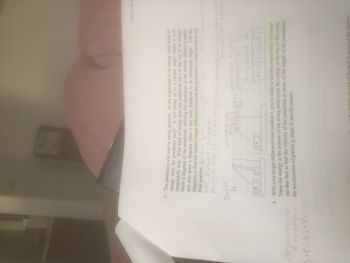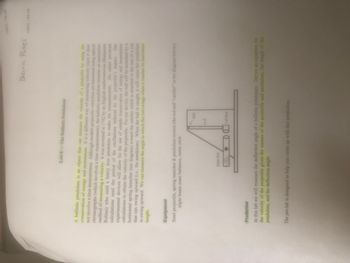Question

Transcribed Image Text:Conservation
of energy =
+ P₁= K₂ + P²₂
N
3. The pendulum will start to swing upwards. At the beginning of its swing, what kind of
energy does the pendulum have? It will swing up to a certain angle where it will
temporarily stop. What kind of energy does the pendulum have at the top of its swing?
Draw a diagram of the pendulum, showing the pendulum at the bottom (where it starts)
and also draw a diagram when it has been displaced to its maximum angle. Use the
diagrams to find the vertical height difference between the pendulum's initial position and
final position. At the beginning of its swin
has kinetic energy
At the top of its swing,
pe
Start
U
maximum
angle.
2
Jello
Pendulum has gro
Potentiale
vertical he
difference=
h=1-1 cose
d
4.
With your height difference from number 3, you're ready to use the conservation of energy.
Since the energy at the bottom of the swing must equal the energy at the top of the swing,
use that fact to find the velocity of the pendulum in terms of the length of the pendulum,
the acceleration of gravity g, angle 0, and the masses.
11/9/22, 7:56 AB
2
h=((1-cos)
ball
of the masses.

Transcribed Image Text:Lab 8- The Ballistic Pendulum
A ballistic pendulum is an object that can measure the velocity of a projectile by using the
conservation of energy and momentum. It is a different way of measuring velocity since it does
not involve a time measurement. Although modern projectile velocities are measured using optical
chronographs (which involves a time measurement), the ballistic pendulum remains an instructive
method of measuring a velocity. It was invented in 1742 by an English mathematician (Benjamin
Robins) who used a heavy iron pendulum to make his measurements. His rather involved
calculations used the period of the oscillations induced by the projectile's impact. Our
experimental devices will allow for the use of simple conservation of energy and momentum
calculations to obtain the velocity of the projectile. For our device, the ball will be launched by a
horizontal spring launcher (see diagram) toward the catcher which is attached to the end of a rod
that can swing upward (i.e., the pendulum). When the ball is caught, it will cause the pendulum
to swing upward. We can measure the angle to which the rod swings when it reaches its maximum
height.
Equipment
Steel projectile, spring launcher & pendulum system (the rod and "catcher" in the diagram below),
triple beam mass balances, meter stick
launcher
0010
axle
rod
Dhara Patel
catcher
Prediction
In this lab we will measure the deflection angle of a ballistic pendulum. Derive an equation for
the velocity of the projectile given the masses of the projectile and pendulum, the length of the
pendulum, and the deflection angle.
The pre-lab is designed to help you come up with this prediction.
11/9/22, 7:56 AM
11/9/22, 7:56 AM
Expert Solution
This question has been solved!
Explore an expertly crafted, step-by-step solution for a thorough understanding of key concepts.
This is a popular solution
Trending nowThis is a popular solution!
Step by stepSolved in 2 steps with 1 images

Knowledge Booster
Similar questions
- 2. The given figure shows an Atwood machine with two blocks that weigh 10.0 kg and 5.0 kg. These blocks are connected by a massless string that goes along a frictionless and massless pulley. Suppose a spring has a force constant of 1 500 N/m on a pit as shown in the figure. a. Using the law of conservation of energy, find the speed of the 10-kg block when it reaches the end of the spring if the system will be released from rest. b. What will be the maximum compression length of the spring when the heavier block hits it? 5.0 kg 10.0 kgarrow_forwardA 25.0 kg child is on a swing having a high point 1.85 m above the ground and a low point 0.500 m above the ground. At the highest point of the swing, what is the child’s potential energy? At the highest point of the swing, what is the child’s kinetic energy? At the highest point of the swing, what is the child’s total energy? At the lowest point of the swing, what is the child’s total energy? At the lowest point of the swing, what is the child’s potential energy? At the lowest point of the swing, what is the child’s kinetic energy? At the lowest point of the swing, what is the child’s speed?arrow_forwardThere is a 2.02 kg box at three points in time. Initial the box is moving to the left at 12 m/s. A. How much kinetic energy is does the box have while moving to the left in time 1? _________ JoulesB.The box then hits into a spring with a spring constant of 534 N/m. At the point of max compression all of the boxes kinetic energy goes into elastic potential energy. How much is the spring compressed at that point ______ metersarrow_forward
- 2. The potential energy function associated with a force acting on a system is U = 3x3 – 5x. a) What is the equation for force for this system? b) Draw a graph of the potential energy. Indicate the points of equilibrium and note whether they are stable, unstable or neutral.arrow_forwardI need help with this questionarrow_forwardA ball weighing 0.2kg rolls along the ground. It has a speed of 3 m/s eventually rolls up a hill. a). Calculate the total energy of the ball b). At its highest point on the hill, the ball as a height of 0.1m above the ground. Is energy conserved for the ball?arrow_forward
- the potential energy of a particle is given by U(x)= (9 J/m^4)x^4-(8 J/m^2)x^2. At what value of x would the particle be in unstable equilibrium? A.) -2/3 m B.) sqrt of 8/9 m c.) 0 m d.) 2/3 m e.) sqrt of - 8/9 marrow_forwardYou are loading a toy dart gun, which has two settings, the more powerful with the spring compressed twice as far as the lower setting. If it takes 5.0 J of work to compress the dart gun to the lower setting, how much work does it take for the higher setting? a. 20 J b. 10 J c. 2.5 J d. 40 Jarrow_forward3. A 60 kg snowboarder begins to slide down the hill 50 m high on a smooth surface with a radius curvature of 80 m. The next section (AB) is a 20 m flat rough track with u = .3, at the end of which there is an elastic barrier with k = 1000 N/m. Find her speed at point A. b. How much work is done by frictional force? c. What is the maximum compression of the spring? d. Find the rate of heat dissipation along the section AB. e. How long does it take to cover the section AB? а. h k Вarrow_forward
- The final answer should be in three decimal places.arrow_forwardA child has two red wagons, with the rear one tied to the front by a stretchy rope (a spring). If the child pulls on the front wagon, the ____ increases. a. kinetic energy of the wagons b. potential energy stored in the spring c. both A and B d. not enough informationarrow_forwardBase your answers to questions 6 and 7 on the following graph taken from an experiment with a spring of original length 1.0 m. 30 25 20 Force 15 (N) 10 5 .01 .02 .03 .04 .05 Increase in spring's length (m) 5. What is the spring constant of the spring? 6. What is the potential energy stored in the spring when it has been stretched 0.04 m from its original length?arrow_forward
arrow_back_ios
SEE MORE QUESTIONS
arrow_forward_ios